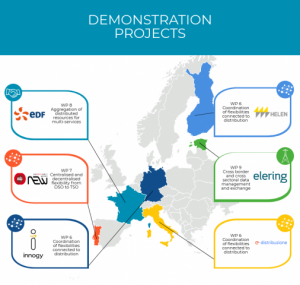EU-SysFlex blog: EU-SysFlex demonstrations enable flexibility in a power system with a high share of renewables
30.08.2019News The concepts for enhancing system flexibility are tested in seven European large-scale demonstrators.
The concepts for enhancing system flexibility are tested in seven European large-scale demonstrators.
EU-SysFlex focuses on improving flexibility and system services to address technical challenges arising from the continuously increasing share of renewable energy resources (RES) in our electricity supply. The concepts for enhancing system flexibility are tested in seven European large-scale demonstrators. Concepts and results are also shared with Ireland, which is already trialling some new technologies to address system services in project’s work package Integration of services into System Operator Control Centres (WP4)
With specificities for each demonstrator, two main approaches are taken in the project:
- Accessing the renewable generation and flexibility sources on the distribution system level by enhancing the distribution system operator’s (DSO) tools in coordination with the transmission system operator (TSO), in order to address overall power system’s future needs;
- Aggregating the decentralized renewable generation and flexibility sources through Virtual Power Plants concept, in order to provide significant and reliable volumes of energy and services to the power system, including innovative services needed in the future system with high RES.
As described in previous blog and visualized in the picture below, in the work package Coordination of flexibilities connected to distribution (WP6), three of those physical demonstrators – located in Germany, Italy and Finland – analyse and test the exploitation of decentralized flexibility resources connected to the distribution system for ancillary services provision to the TSOs. They demonstrate hardware and software solutions to enhance the coordination between TSOs and DSOs. This objective is shared with the Portuguese FlexHub in the work package Coordination centralized and decentralized flexibilities (WP7).
In this demonstration, the FlexHub tool operates as a flexibility market facilitator, coordinated by the DSO, providing ex-ante and real-time technical validation with “traffic light concept” of active power flexibilities from resources connected to the distribution system which can be activated by the TSO. The FlexHub also provides control of resources on the DSO grid for reactive power provision, and equivalent model to simulate the dynamic response of the DSO grid under frequency and voltages disturbances at the TSO/DSO interface node.
The other demonstration in Portugal (WP7), as well as a large part of the Finnish demonstration (WP6), and the French demonstration (work package Aggregation of distributed resources for multi-services, WP8) focus on the Virtual Power Plant (VPP) approach. They aggregate different and complementary types of assets for renewable generation, storage and controllable load in order to provide energy and system services to the TSO.
The Portuguese VPP aggregates wind farms and large hydro plants both connected to the transmission level to provide energy and system services. It tests the optimized operation of a variable-speed pumped storage power plant with capacity to provide dynamic FRR (Frequency Restoration Reserve) combined with wind farms, as well as demonstrating the ability of the aggregated portfolio to provide flexibility to the system, namely ancillary services.
The Finnish and French VPP add a large battery as storage system to deliver faster frequency responses. The Finnish demonstration aggregates low-voltage distributed resources such as residential controllable loads, electric vehicle infrastructures, and a PV farm, to demonstrate the capability to participate in the real market for energy and flexibility, including Frequency Containment Reserve.
The French VPP, which is located in an EDF-owned network for testing – the Concept Grid Lab – will be able to demonstrate even faster frequency responses, multi-services responses and responses to contingencies, aggregating a battery, a wind farm, PV panels, and controllable loads. When aggregated and controlled, the decentralized and distributed flexibility resources provide various efficient and reliable services and solve a set of scarcities such as frequency deviations, voltage violations and congestions. Additionally, while tackling those scarcities, the demonstrators show different strategies to improve the coordination between stakeholders: TSO, DSO and also energy and flexibility providers.
These approaches are completed by different sets of Estonian demonstrations specific to data management, grouped in the work package Cross border and cross sectoral data management and exchange (WP9), in order to demonstrate different concepts of flexibility and data exchange platforms. The digitalization of the power system is at the same time an important requirement and a challenge in the various technical solutions developed in the project. It also adds the cross-border and cross-sector perspectives to the energy exchange flows.
Written by: Marie-Ann Evans, Technical Manager of the EU-SysFlex Project.
For further information please follow us on www.eusysflex.com, LinkedIn, Twitterand Facebook.
Disclaimer: blog entries reflect individual views of the author(s) that may not reflect official positions or communication of the project / project consortium.